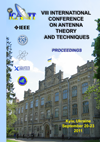Biochemical observational science at THz energies
DOI:
https://doi.org/10.1109/ICATT.2011.6170706Keywords:
THz, THz radiationAbstract
In this overview we will explore how current terahertz (THz) and sub-THz experimental systems are being used in a variety of ways to visualise and indeed, controllably excite biochemical processes. For example, a contributing cause to disease is known to be due to mis-folding proteins. But how proteins fold in order to perform a biological task is a deep mystery. The difficulty in understanding what happens comes from not being able to ‘see’ clearly what happens experimentally. Sub-THz spectrometry based on high resolution systems (vector network analysers) can record vibrational modes from absorption spectra.
Antenna engineering presents biology with a means for understanding their molecular systems as equivalent electrical circuits. From the measured frequency absorption spectra of the protein we seek to learn from the protein’s vibrational structure, its folding trajectory. Finally we will look at how deliberate, targeted, excitation of specific vibrational modes of molecules can be used to effect new reaction pathways to create an intelligent and engineered approach to RF-assisted chemistry.
References
SNEPPEN, K.; ZOCCHI, G. Physics in Molecular Biology. CUP, 2005, doi: http://dx.doi.org/10.1017/CBO9780511755699.
BEARD, MATTHEW C.; TURNER, GORDON M.; SCHMUTTENMAER, CHARLES A. Terahertz Spectroscopy. J. Phys. Chem. B, 2002, n.106, p.7146-7159, doi: http://dx.doi.org/10.1021/jp020579i .
PLUSQUELLIC, D.F.; SIEGRIST, K.; HEILWEIL, E.J.; ESENTURK, O. ChemPhysChem, 2007, v.8, p.2412-2431.
WHITBY, R.J.; MARSDEN, S.P. Dial-a-Molecule. 100% efficient synthesis. EPSRC Reference - EP/H034447/1.
POLSHETTIWAR, VIVEK, VARMA, RAJENDER S. Aqueous microwave chemistry: a clean and green synthetic tool for rapid drug discovery. Chemical Society Reviews, 2008, v.37, p.1546-1557, doi: http://dx.doi.org/10.1039/b716534j.
PARKER, STEWART F.; BRADEN, DALE A.; TOMKINSON, JOHN; HUDSON, BRUCE S, Full longitudinal acoustic mode (LAM) spectrum of an n-alkane: Comparison of observed and computed incoherent inelastic neutron scattering spectrum of n-octadecane. Journal of Physical Chemistry B, 1998, n.102, p.5955-5956, doi: http://dx.doi.org/10.1021/jp982101d.
LAIB, J.P.; HALLQUIST, A.T.; MROZACK, A.M.; MITTLEMAN, D.M. Terahertz vibrational modes in non-polar non-hydrogen-bonding crystalline solids. Proc. of Conf. on Quantum Electronics and Laser Science, 4-9 May 2008, San Jose, CA. IET, 2008, p.1590-1591, http://ieeexplore.ieee.org/xpl/login.jsp?tp=&arnumber=4571982&url=http%3A%2F%2Fieeexplore.ieee.org%2Fxpls%2Fabs_all.jsp%3Farnumber%3D4571982.
ALLIS, D.G.; FEDOR, A.M.; KORTER, T.M.; BJARNASON, J.E.; BROWN, E.R. Assignment of the lowest-lying THz absorption signatures in biotin and lactose monohydrate by solid-state density functional theory. Chemical Physics Letters, 2007, v.440, n.4-6, p.203-209, doi: http://dx.doi.org/10.1016/j.cplett.2007.04.032.
ROGGENBUCK, A.; SCHMITZ, H.; DENINGER, A.; MAYORGA, I. CAMARA; HEMBERGER, J.; GUSTEN, R.; GRUNINGER, M. Coherent broadband continuous-wave terahertz spectroscopy on solid-state samples. New Journal of Physics, 2010, V.12, p.043017, doi: http://dx.doi.org/10.1088/1367-2630/12/4/043017.
BROWN, E.R.; BJARNASON, J.E.; FEDOR, A.M.; KORTER, T.M. On the strong and narrow absorption signature in lactose at 0.53 THz. Applied Physics Letters, 2007, v.90, n.6, p.3, doi: http://dx.doi.org/10.1063/1.2437107.
PEREVERZEV, ANDREY; SEWELL, THOMAS D. Terahertz normal mode relaxation in pentaerythritol tetranitrate. Journal of Chemical Physics, 2011, v.134, n.1, p.10, doi: http://dx.doi.org/10.1063/1.3518423.
JEWARIYA, M.; NAGAI, M.; TANAKA, K. Ladder Climbing on the Anharmonic Intermolecular Potential in an Amino Acid Microcrystal via an Intense Monocycle Terahertz Pulse. Physical Review Letters, 2010, v.105, n.20, doi: http://dx.doi.org/10.1103/PhysRevLett.105.203003.

